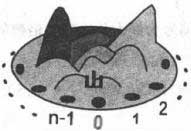Wolf and Rabbit
Time Limit: 2000/1000 MS (Java/Others) Memory Limit: 65536/32768 K (Java/Others)
Total Submission(s): 7684 Accepted Submission(s):
3870
Problem Description
There is a hill with n holes around. The holes are
signed from 0 to n-1.

A rabbit must hide in one of the holes. A wolf searches the rabbit in anticlockwise order. The first hole he get into is the one signed with 0. Then he will get into the hole every m holes. For example, m=2 and n=6, the wolf will get into the holes which are signed 0,2,4,0. If the rabbit hides in the hole which signed 1,3 or 5, she will survive. So we call these holes the safe holes.

A rabbit must hide in one of the holes. A wolf searches the rabbit in anticlockwise order. The first hole he get into is the one signed with 0. Then he will get into the hole every m holes. For example, m=2 and n=6, the wolf will get into the holes which are signed 0,2,4,0. If the rabbit hides in the hole which signed 1,3 or 5, she will survive. So we call these holes the safe holes.
Input
The input starts with a positive integer P which
indicates the number of test cases. Then on the following P lines,each line
consists 2 positive integer m and n(0<m,n<2147483648).
Output
For each input m n, if safe holes exist, you should
output "YES", else output "NO" in a single line.
Sample Input
2
1 2
2 2
Sample Output
NO
YES
Author
weigang Lee
Source
Recommend
其实此题稍加思索就可以知道,若n,m不互质,则一定有安全洞口的存在

1 #include "bits/stdc++.h" 2 using namespace std; 3 typedef long long LL; 4 int cas; 5 int n,m; 6 int gcd(int a,int b){ 7 if (b==0) return a; 8 else return gcd(b,a%b); 9 } 10 int main(){ 11 freopen ("wolf.in","r",stdin); 12 freopen ("wolf.out","w",stdout); 13 int i,j; 14 scanf("%d",&cas); 15 while (cas--){ 16 scanf("%d%d",&n,&m); 17 if (gcd(n,m)==1) 18 puts("NO"); 19 else 20 puts("YES"); 21 } 22 return 0; 23 }
